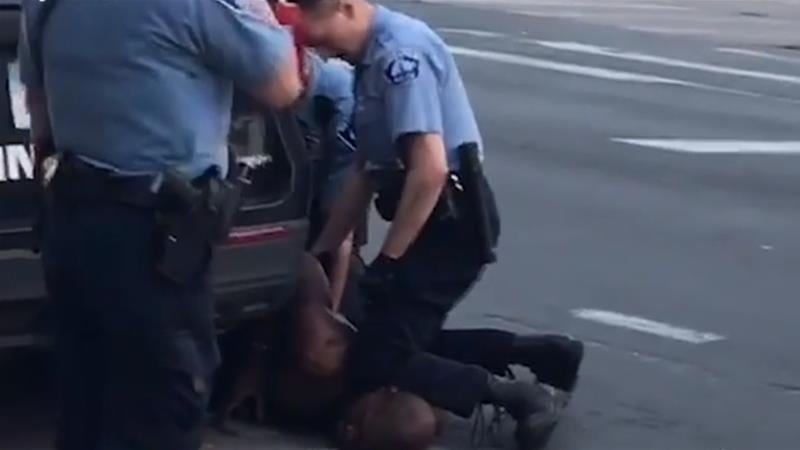The Minneapolis Police Department, in a training manual issued to all new officers, detailed how to execute the same neck restraint that killed George Floyd, lawyers for one of the officers involved in the May 25 incident argued in a Wednesday motion.
The training manual, which provided pictures of the “non-deadly” maneuver in which officers put an arm or leg on the back of a suspect’s throat if they are resisting arrest, was filed Wednesday in a motion to dismiss the charges against Thomas Lane—one of four officers charged in Floyd’s death.
The manual included a PowerPoint slide with a photo of the restraint in practice under the title, “Ok they are now in handcuffs now what.” It said, “Sudden cardiac arrest typically occurs immediately following a violent struggle.” It advised officers to put suspects in the recovery position to avoid positional asphyxia and call emergency services once the person was in handcuffs.
The documents provide new details into the systematic departmental missteps that led to Floyd’s botched arrest, which sparked mass protests in 50 states against racial injustice and police brutality.
Lane and his former colleagues, Alexander Kueng and Tou Thao, are charged with aiding and abetting second-degree murder while committing a felony, and with aiding and abetting second-degree manslaughter with culpable negligence for Floyd’s death. Derek Chauvin, the officer who held his knee on George Floyd’s neck while the handcuffed Black man repeatedly said he couldn’t breathe, is facing several charges including second-degree murder.
All four men were fired from the Minneapolis Police Department one day after the explosive footage of the arrest was released.
Earl Gray, Lane’s attorney, argued Wednesday his client’s case should be dismissed for lack of probable cause. He said the rookie officer asked twice if they should turn Floyd on his side during the arrest. Chauvin, who was Lane and Kueng’s field training officer, repeatedly said no.
The motion also contained a transcript of Lane’s interview with state investigators and transcripts of body camera footage from Lane and Kueng. His attorney said both showed Lane’s apprehension toward the neck restraint and proved that Lane was “going off Officer Chauvin’s experience and what he was saying” as a law enforcement veteran.
“Officer Lane did not know there was a felony being committed or attempted when Chauvin was kneeling on Floyd,” the motion states. “If in fact a felony was committed or attempted. The training material supports that neck restraint was something taught to officers.”
“Lane is a trained police officer who, although new to the job, knew that officers are allowed to use reasonable force when needed,” the document adds. “Based on Floyd’s actions up to this point, the officers had no idea what he would do next—hurt himself, hurt the officers, flee, or anything else, but he was not cooperating.”
Prosecutors allege that Lane and Kueng initially responded to a call at 8:08 p.m. on May 25 that Floyd had used a counterfeit bill at a CupFoods.
When the two rookies, who had been full-time officers for less than a week, found Floyd outside in his car, along with two passengers, they asked him to get out. The criminal complaint says Lane then pointed a gun at Floyd and ordered him to show his hands. When Floyd put his hands on the steering wheel, Lane put his gun away and pulled the 46-year-old out of the car.
“I’m sorry, I’m so sorry. God dang man. Man, I got shot. I got shot the same way, Mr. Officer, before,” Floyd told Lane when he drew his gun, according to a transcript from Lane’s body camera footage.
The motion states that after having a two-minute conversation with the officers outside his car, Floyd stiffened up, fell to the ground and said he was claustrophobic as they tried to put him inside a squad car.
“Oh man, God don’t leave me man, please man, please man,” Floyd pleaded to the officers, the transcript states. Lane offered to sit in the squad car with Floyd, roll the windows down, and turn on the air conditioning but Floyd continued to resist, the motion says.
“I’m not that kind of guy, man, I’m not that kind of guy... and I just had COVID, I don’t want to go back to that,” Floyd said, a reference to a COVID-19 diagnosis that was later confirmed in an autopsy.
Chauvin and Thao then arrived, and all four men tried to get Floyd in the car, but he kept falling down and saying he couldn’t breathe, the criminal complaint states. The four officers ended up bringing the 46-year-old to the ground because “Floyd was out of control,” the motion states.
“Lane said, let’s use the ‘MRT’, Maximum Restraint Technique, which is what you use on someone who is handcuffed and not complying,” the motion states, referring to the MPD training manual. “Lane suggested using the hobble because he learned that that is what to use when you have someone who is handcuffed that is physically resisting.”

Thomas Lane, right, at a previous court hearing with attorney Earl Gray.
TNS/ABACA via Reuters ConnectThe motion states that “Lane was trying to get Floyd’s legs into a leg cross” for the hobble maneuver but “Floyd was kicking around.” At that point, “Chauvin had his knee up around the [Floyd’s] shoulders and neck area’’ Lane told state investigators.
The criminal complaint states that Kueng held Floyd’s back and Lane held his legs—while Chauvin placed his knee on the unarmed man’s neck. The move prompted Floyd to call out for his mother and say several times that he couldn’t breathe. “I’m about to die,” he warned, the complaint states.
“All right, all right. Oh my god. I can’t believe this. I can’t believe this... Mom, I love you... Tell my kids I love them. I’m dead,” Floyd said, according to Lane’s body camera transcript. Chauvin responded, “You’re doing a lot of talking, man.”
Lane asked several times if Floyd should be rolled onto his side, and several times Chauvin told him no, according to both the criminal complaint and Lane’s motion. In one instance, Lane said he was worried about “excited delirium or whatever” after learning “in the Academy when someone is on drugs, they work themselves up and they can have issues from that.”
When Floyd stopped moving at around 8:24 p.m., Lane again suggested moving him onto his side, while Kueng checked for a pulse but couldn’t find one. The officers never changed Floyd’s position, prosecutors said. EMTs told investigators that when Floyd was loaded into an ambulance, he had no pulse.
According to body-camera footage, Chauvin had his knee on Floyd’s neck for 8 minutes and 46 seconds—including nearly three minutes in which Floyd was unresponsive.
“This was the first day Lane and Kueng rode together as partners,” the dismissal motion states.“During the encounter with Floyd, Lane was ‘going off Officer Chauvin’s experience and what he was saying,’ hold him here until EMS arrives.”
“Lane was aware that Chauvin had 20 years on,” the document states, stating that throughout the field training process, officers are told to “trust and go to your senior officers for experience and help on calls, and the best thing to do in a situation, they give direction and you follow their lead. Another expectation is to call senior officers “sir” when you are a new officer.”
The Hennepin County Medical Examiner said Floyd died due to cardiac arrest from the restraint and neck compression. The medical examiner’s office report also said there were indications Floyd had heart disease, including “arteriosclerotic and hypertensive heart disease,” and there was fentanyl in his system. An independent report commissioned by Floyd’s family, however, concluded that the 46-year-old was in good health and died of strangulation from the pressure to his back and neck. Both reports determined Floyd’s death was a homicide.
“It's not a case where he’s standing by watching another cop pound on somebody's head," Gray told the Star Tribune on Wednesday. “This is a case where my client twice—twice—asked if we should turn him over and the answer from [Chauvin] was no.”








